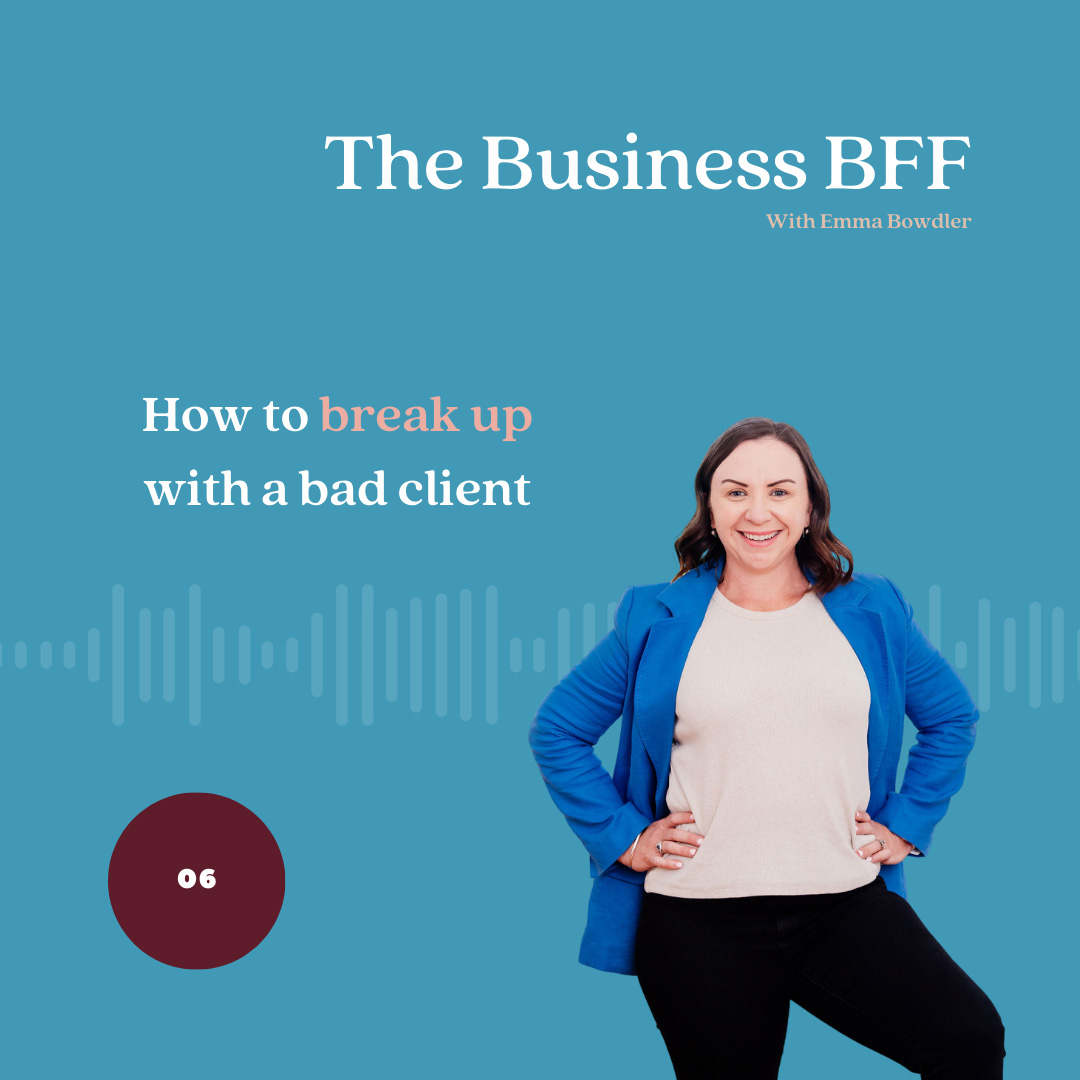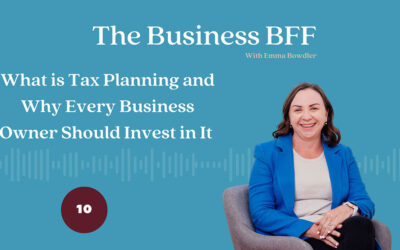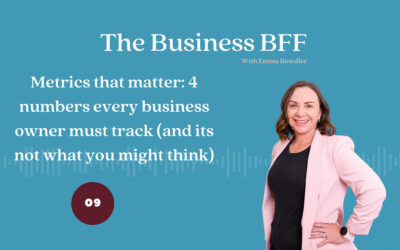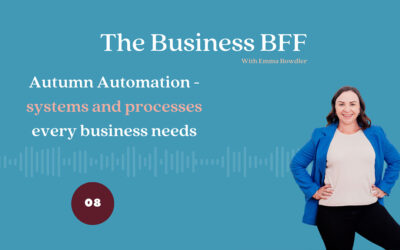The Business BFF Podcast – Episode 6:
Breaking Up with a ‘Bad’ Client (and How to Attract the Right Ones)
14 March 2025
Not all clients are good clients—and if you’ve ever dealt with late payers, constant scope creepers, or energy-draining nightmares, you know the struggle. In this episode, Emma gets real about when (and how) to break up with clients who are holding you back.
You’ll learn the red flags to watch for, how to set boundaries with confidence, and—most importantly—how to attract the kind of clients who respect your time, value your work, and actually pay on time. Because your business (and sanity) deserve better.



Episode 6: Breaking Up with a ‘Bad’ Client (and How to Attract the Right Ones)
temp
Episode Transcript:
[00:00:00] Emma: We’ve all got them. Those clients that we love to hate. You know the ones, they’re chronic late payers. They push the boundaries. They are the ones who influx your inbox with requests that are completely unreasonable. We’ve all been there. So in today’s show, we’re going to dive into how to handle them with professionalism and grace without sacrificing your sanity.
[00:00:28] We’ll unpack why it’s important to set your standards, how to recognize when it’s time to part ways, and the art of breaking up with the client respectfully. If you’ve got a client that you love to hate, then this episode is for you.
[00:00:46] Welcome to the Business BFF, the podcast where fierce and fabulous business women come together for the kind of real talk and honest advice only your besties would give. I’m your host, Emma Bowdler, founder of The [00:01:00] Women’s Accountant, and I’m here to help you navigate the wild world of business, finance, and life, whether you’re scaling up Starting fresh or just need a pep talk from someone who gets it, you’re in the right place.
[00:01:14] So grab your favourite bevy and get comfy. It’s time for a chat with your business BFFs.
[00:01:20] Emma: It’s never nice breaking up with the client, but ultimately sometimes it’s really, I guess it’s needed for you.
[00:01:31] So there’s a bit of a process that we go through here at the women’s accountant. And the very first thing that we always do is we set our standards. So we start with our non negotiables. What are the behaviors? What are the values, the types of clients that just don’t fit with our business? Maybe they are the type of clients who they always pay late.
[00:01:58] Maybe they’re the type of [00:02:00] clients who disrespect your boundaries. What that looks like, are they calling it all hours? Is there a consistent scope creep? Are they the clients who question your expertise or make really unreasonable demands? The ones, the ones that I need this in, 24 hours, whatever that kind of looks like for you and your business.
[00:02:25] But it’s really important as a business owner is to, I guess, set those boundaries. And if you have, if they’ve been a little bit lax. Which we all have
been there, you can, you can retrain a client, I believe, we’ve been able to do that over the last, five years, but what are you willing to accept and what are you not willing to accept?
[00:02:50] So write down the deal breakers, what does that look like? And be really specific about what you won’t tolerate. [00:03:00] We have a really clear engagement letters here at the Women’s Accountant, really clear expectations around the communications, when I’m available, when I’m not available, and if you can communicate those to your clients from the very first meeting, these things can be avoided and you can then have those conversations with them down the track about, hang on, remember, these are the things that we don’t do.
[00:03:25] What’s in scope, what’s out of scope. Now, if you’re like me, there might be a few signs that you recognize when it’s time to break up with a client. Now, if you were really honest with yourself and you were to look at all of your clients, You would be able to go through that client list and go, well, which of those clients are draining your energy?
[00:03:51] Maybe they’re draining your time or they just not profitable. So some of the signs that we see [00:04:00] regularly is that it’s time to break up with the client is that real feeling of dread. every time their email or their name pops up in your inbox. This has personally happened to me. And it got to the point where, I would see the email and I would just be like, Oh my God, what now?
[00:04:21] And while I was feeling that way, my team were also feeling that way as well. So that was a really good indicator. that things weren’t kind of going right. Some of the other common signs that we see is that they repeatedly ignore the boundaries that you’ve set, or they don’t meet the expectations of an ideal client.
[00:04:46] And, The last one there is that they’re costing you more time and stress than they’re worth financially. And, when I think about this one particular client, it was quite a meaty [00:05:00] job. It was probably worth between eight and 10, 000 a year. And when I actually deep dove into the time that we were spending on this job versus money, the value, the, dollars in the bank, they just were so misaligned and they weren’t the type of client that just made me feel good in general.
[00:05:25] So while I was letting go of, a 10, 000 a year client, I was able to replace that with some really beautiful clients where you know, our values did align. So, if what I would encourage you to do is have a look at your current client list and identify anybody who doesn’t align with your values or your non negotiables.
[00:05:51] Now, if I was a betting woman, which I’m not I would hazard a guess that you probably know who they [00:06:00] are already. So if you’ve then made that list, well, what’s the next step? How do we break up with those clients professionally? So we’ve got a couple of scripts that we use, a couple of email templates.
[00:06:16] I will drop them for you in the show notes, but basically there’s a couple of really clear things that we put in there. So we make it clear, we make it direct and we make it professional. So, What I, when I say that, what I want you to remember is that you’re running a business. You are not running a friendship circle.
[00:06:38] Okay, really clear to distinguish that. So what are those some of those examples might be, After reviewing our work together, I’ve decided that this partnership is no longer the right fit for my business. Whatever that looks like for you. I’ve reassessed my capacity for new projects and I’ll need to wrap this up by X [00:07:00] date.
[00:07:00] And here’s a list of referrals who might be able to support you moving forward. You do not need to apologize and you do not need to over explain, I often see people that will write these things and it’ll be a really big lengthy over explain as to, why we’re terminating the engagement or whatever that looks like.
[00:07:24] This is your business and you get to choose who you work with. You do not need to explain your reasons for disengaging with a client or a customer who doesn’t value your services and where your values don’t align. So, have a crack, write a really simple termination email for a, Hypothetical, difficult client and see how that fits for you.
[00:07:51] Grab the scripts in the show notes and play with those, make them your own, do whatever you want. What I [00:08:00] often see when we have these conversations with business owners is they’re quite reluctant to let go of bad clients when they don’t have that mix of new clients coming in. And I get that.
[00:08:15] This is something that you might want to stage and if you’ve got an accountant or a business advisor, this might be something that you want to discuss with them. Now, if we’re getting rid of bad clients, we need to be able to meet some of the right clients. So what I would encourage you to do here is define who your ideal client is.
[00:08:37] Okay. Now ask yourself, what are the kinds of clients that I love working with? If you are in a, any type of business, really have a look at your client list already and pick out those people who really light you up, who you love working with, who you love spending your time with. [00:09:00] What industries are they in?
[00:09:01] What are their budgets? What are their values? Do their values align with your business goals? What does that look like for you? And then the next step you want to do is audit your messaging. I often see business owners where they go, yeah, I know who my ideal client is. And then I look at their website and they’re completely misaligned between, Who they want to attract and who they are actually attracting.
[00:09:30] Is your messaging speaking directly to your dream clients? And if not, you need to change that up. So when you are meeting the right clients, What you need to do as part of that onboarding process is to set really clear expectations up front. We have a really robust onboarding system here at the Women’s Accountant.
[00:09:53] I will meet with every or every Myself or Emily will meet with every prospect. We will [00:10:00] then come together as a team and discuss the different needs of the clients. And are they the best fit for us? I guess what I’ve learned in the last almost 20 years of business is that not everybody’s the right fit for you.
[00:10:15] And when you’ve been doing this job, as long as I have, I have the ability to pick and choose who I work with. And if it’s not a fit, if it’s not a hell yes, then it’s a no for us. So write a description of your dream client. Who are they? What are they doing? What are their personality traits and why are they the kind of people that you want to work with?
[00:10:41] Then use that to audit your messaging and see if those align. If not, then that might be something that you need to change up. So the next thing and I’ve just mentioned this is to raise your standards, gone are the days where, [00:11:00] Emma, the business advisor, 10 years ago used to work with anybody with a wallet and a heartbeat.
[00:11:06] I’ve been able to reframe that mindset and not everybody deserves. To work with me and that’s okay. The reality is I’m not for everybody. And again, that’s okay. So I’m never going to feel upset or offended if I’ve done a new client consult and they don’t. We don’t vibe like that doesn’t upset me anymore.
[00:11:29] I’m more than happy to refer those people on. So what are some of the examples of raising the bar? So saying no to clients who want discounts or they don’t align with your goals. Another one I can think of is using really clear boundaries. In those engagement letters, in those contracts, in whatever that looks like.
[00:11:51] So, what are your offers, office hours, what’s in an engagement, what’s out of engagement, what does that look like? [00:12:00] Raising the bar looks like only taking on clients who respect your expertise. This is a big one for me. And if you’ve been I guess if you’ve dealt with a few accountants, if you’ve seen what’s happening in the industry, it’s probably been more progressive in the last, eight or 10 years than it has in my entire career.
[00:12:22] But what I’m certainly seeing is that accountants who are playing this race to the bottom, undercutting, undercutting, and then, just really diluting the value of what it is that we do. I’m not interested in that, in playing that game. So I will only take on clients who respect my expertise.
[00:12:43] And, they, if they, I guess if they respect my expertise, often they are a really good alignment anyway. So have a look at what that looks like for you. If you need to go back and update your onboarding process, then [00:13:00] absolutely do that. Make sure that those engagements are really clear as to what’s in and what’s out.
[00:13:07] I actually have a client handbook that has a list of expectations that, these are the things, these are who you as a client need to be in order to work with us, and that’s been a really great way I guess to raise those standards and it also holds clients accountable too, which has been really, really good.
[00:13:29] So breaking up with clients isn’t just about cutting ties. It’s also about creating space for better opportunities. So. For every one crappy client you get you, for every five crappy clients you get, you might only get one good one. But the reality is the value you can add to that client is so much higher.
[00:13:51] So I guess some of the benefits are, it’s, you can be, Doing more time for higher value work, which I think is super important. [00:14:00] It’s also less stressful and you can be creating better energy and higher energy for those dream projects that you might want to do. And. I guess there’s a really important reminder there that every minute that you spend on a bad client is a minute that you’re not spending on a good client.
[00:14:25] So, sometimes when you think about breaking up with those clients, have a think about what it is actually costing you. And more often than not, It
makes a really, it makes for a really easy decision as to how you can get get rid of them, I guess. And, there’s a ways and means of breaking up with clients that, can actually be really beautiful.
[00:14:49] I’ve had clients where we have outgrown each other, which is really wonderful. I’ve started with this business in that space. and we’ve built something really beautiful and [00:15:00] highly profitable and, multi million dollar business now. And they’ve then expanded into other countries, which is out of my scope.
[00:15:10] So, I’ve happily. broken up with those good clients as well in a really beautiful way that allows them to be supported in a way that their business needs moving forward. So just as a bit of a sum up, we’ve all had those clients who test our patients, but the reality is you don’t need to keep them by setting really clear boundaries and standards.
[00:15:35] It is a part of you as a person stepping into your role as a business owner. Letting go of a client who doesn’t align with your values or goals isn’t a failure. It’s actually a really smart business move. So the challenge I set for you is to identify just one client relationship that isn’t [00:16:00] serving you and start the process of creating space for better opportunities.
[00:16:06] Remember, it’s your business and your rules and you get to decide who’s worth your time and energy.
[00:16:17] Thanks for tuning in to The Business BFF. We hope you found this episode equal parts big hug and kick up the bum. All the things a bestie is good for. Remember you’ve got this and we’ve got your back like only a BFF can. If you’ve loved what you’ve heard be sure to subscribe, leave a review and share it with your fellow business besties.
[00:16:41] Don’t forget to follow us on social media at The Women’s Accountant. For more tips, tricks, and behind the scenes fun, until next time, keep being fierce and oh so fabulous.
[00:16:53] If this episode made you go, yes, M, I get it now, then I would [00:17:00] love to hear from you. Shoot me a DM over on Instagram at the Women’s Accountant or share it with someone who needs a little nudge to get their head around this too.
[00:17:11] Mhm. Mhm.
Latest Episodes:
Episode 10: What is Tax Planning and Why Every Business Owner Should Invest in It
Think tax planning is just for the big end of town? Think again. In this episode, we’re ditching the eye-rolls and diving into how being strategic with your tax can save you money, reduce stress, and give you more control in your business.
Episode 9: Metrics that Matter – 4 Numbers Every Business Owner Must Track (and it’s Not What You Might Think)
Forget obsessing over revenue alone—if you really want to grow your business, you need to track the right numbers. In this episode, Emma Bowdler breaks down four key metrics that most business owners overlook but can make all the difference to your bottom line.
Episode 8: Autumn Automation – Systems & Processes Every Business Needs
In this episode, Emma breaks down the essential processes every business needs to save time, reduce stress, and create a business that runs smoothly—even when you’re not there.
📧 Join Our Mailing List
Never Miss
an Episode:
Join Us!
Subscribe to our mailing list to receive the latest updates from The Women’s Accountant straight to your inbox:




